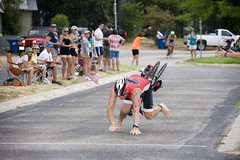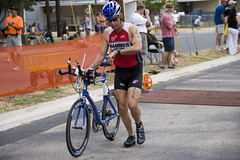One of the funny quirks of the bicycle business is pedals. Bikes are typically sold without pedals and there are what seem like a zillion different types. For the triathlete, especially one who comes from a running background, this is both confusing and can get very expensive if the wrong decisions are made.
A triathlete needs to consider one big issue before choosing a pedal type. This is, “Will I leave the shoes mounted on the bicycle in the transitions, or not?” This is such a strong determinant of pedal and shoe needs that we need to define either Type A, those who leave the shoes on the bike at all times, running barefooted to and from transition, or Type B, those who don their shoes at the transition, run to the bike mount line and clip in, then at T2, unclip and run in the cycling shoes to the racking station.
The reasons for this are as follows. If you have to run in your cycling shoes, the cleats could pick up mud or worse, cause you to slip and fall. Both are big time wasters in a race against the clock. If you leave your shoes on the bike, you have a different problem. The cleats won’t pick up mud, but the straps of the shoes could get caught in between the chain and the big chainring. Not cool.
Now we can talk about pedals. A modern bicycle pedal has to do two things. First it has to have a clip system that will allow the shoe to easily attach, hold the foot in position in all normal cycling moves and of course, unclip easily in case of stopping or crashing. Second, it has to transfer the energy from the rider’s foot to the crank arm efficiently.
There are three major types of pedal systems, while there are many sub types. For the purposes of this article, I will call them Speedplay type, which has a big cleat, metal walking surface and internal clips, Look type (which includes Shimano, Campagnolo and other similar types) which have the clips on the pedal, and a plastic cleat that has a fore and aft external tab to mate with the clips, and SPD, or mountain bike type (includes Crank Brothers, etc) which are small metal cleats with external tabs like Look type, but recessed into a shoe with a walking surface.
Each pedal type has advantages and disadvantages. Let’s start with Speedplay. Two variants of Speedplay pedals are available, the X type with unlimited “float” or range of twisting motion, and Zero type with adjustable float. There are Nanogram and Light action subvariants, plus there are optional spindle lengths to adjust for “Q factor” (width between feet while on the bike). Speedplays are double sided, which means that either side of the pedal can receive the cleat. This is a good thing. They also have a lower stack height so the foot rides lower on the pedal spindle. This is a really good thing. Finally, the cleat/pedal combo has a relatively wide surface area on the sole of the shoe, so while the pedal itself is small, the load transfer is good. There is more freedom for the foot to rotate along its own axis, perpendicular to the pedal spindle, which causes some folks to say the load surface is small. This is not the case but in actuality is a good thing because the ankle joint is not directly lined up along the pedal axis. This means that the foot pronates and supinates a bit during the pedal stroke and the Speedplay system gives you some slack.
The downsides to Speedplay pedals in triathlons are twofold: First, they are subject to picking up mud in wet transition zones and that can cause big problems clipping in. Second, the cleat springs are very stiff when new and they need some breaking in before you can clip in easily.
Look type pedals are the original “clipless” pedals. They revolutionized cycling as the uncomfortable toe clips and straps were made obsolete overnight. They have variable float based on the type of cleat you use in the Look brand, and many brands also have adjustable spring tension. They are better in muddy transition zones than Speedplays but like Speedplays are tough to run in. It is very easy to slip and fall when your body is full of adrenaline in a transition. Another downside to Looks is the fact that they are single sided, and the cleats also wear quickly.
At the end of the day, I still recommend Speedplay pedals if you are a Type A triathlete. You don’t need to worry about mud since the shoes are already clipped in. You don’t need to worry about the slick cleats either. The real reasons that I like Speedplays best are as follows. 1) The stack height is lower. This is more efficient. 2) The Q factor is more adjustable due to the increased numbers of spindle lengths. 3) They are more aerodynamic, but this is a small difference. 4) The cornering clearance is higher and you can pedal through corners that you would have to coast with other pedals. Granted, this is not a big deal to most triathletes but if we are splitting hairs it counts.
The other pedal type not mentioned was SPD, or mountain bike pedals. If you are a Type B triathlete, I highly recommend you consider this option. You can use shoes that are designed for walking and you can actually run in them safely. The SPD pedals are double sided. You do have some downsides, however. 1) They re less aerodynamic. 2) The platform size is smaller and if you don’t have good shoes you can get hotspots.
We really get down to the type of transition you choose. I strongly encourage you to learn to mount and dismount the bike with the shoes already clipped in. You have to toughen up your feet as you will be running barefooted, but there is a reason the top triathletes use the Type A system. It saves lots of time. If you think about it, a triathlon is a series of mini events, each of which takes a certain amount of time. You can gain or lose lots of time in transitions and some thought and practice focused on the whole transition event will significantly improve your game.

Link to: http://www.flickr.com/photos/kgsbikes/3739338563/in/set-72157621749481034
Caption: Type A dismount properly done. Photo: Kevin G Saunders

Link to: http://www.flickr.com/photos/kgsbikes/3740146284/in/set-72157621749481034
Caption: This is why you need to practice Type A dismounts. Photo: Kevin G Saunders

Link To: http://www.flickr.com/photos/kgsbikes/3739358289/in/set-72157621749481034
Caption: Type B dismount. See how mountain bike shoes would help? Photo: Kevin G Saunders
Kevin Saunders owns KGS Bikes, the worlds premiere custom bicycle boutique. He has spent 25 years becoming an authority on bicycle positioning, design and cycling technique.http://kgsbikes.com, blog, http://blog.kgsbikes.com

